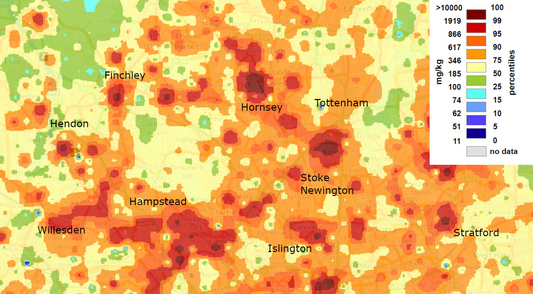About us
Lead Aware UK is on a mission to detect and remove lead particulate in British homes. Here's how we got into this and why we think testing your home for lead is more important than most people realise. |
It all began with chocolate.

I'm a father of two young children. In 2023, I came across an article by Consumer Reports claiming that many brands of chocolate contain high quantities of lead. Since my children eat a lot of chocolate I wanted to get to the bottom of this question and dived into the literature on lead in food, and then lead in water, trying to understand what a safe level of dietary exposure might be.
I emailed several chocolate manufacturers in the UK asking about the level of lead in their chocolate. One of the very few to get back with a figure was the manufacturer I actually bought from the most: 0.3 milligrams/kg, they said. And they comply with all EU regulations on lead in food, they said. OK.
Quick calculation: let's say my child eats 10g of that chocolate per day, that's 3 micrograms of lead per day. What does that mean? Does it matter?
It turns out, yes it does - that's well over the FDA 'reference level' of 2.2 micrograms/day total across all foods. And the only reason it complies with EU regulation on lead in food is because that regulation does not place any limit on lead in chocolate! In the US, where the level is regulated, the chocolate would be illegal.
And then I started coming across other facts:
- One in three children globally have lead poisoning
- Lead kills 5 million adults annually via heart disease alone
- The average British child has lost 2-3 IQ points because of lead poisoning
- The large majority of children in the US have multiple blood tests for lead as a matter of course.
What is going on?
Like most people, I vaguely knew that lead paint was dangerous. I had actually had the mains water in our house tested because I knew about the risk from lead pipes. But I had no idea of the scale or impact of lead pollution in dust and soil and the level of danger posed by something as innocuous as a slightly flaking skirting board. I could not believe how little the issue is reported in the UK, compared to how much is made of it in the US.
There is an enormous amount of highly partial, contradictory and complicated information about lead - it took a lot of sifting to feel like I had a grasp of the issues. I have condensed some of that research in our blog Understanding Lead and especially the article Understanding Lead Exposure Statistics and Harm - hope it helps.
Anyway, we'd just had some renovations done, so I decided to do some dust and paint tests in our house - just like they do in the US as a matter of course. Finding a company that could take dust samples was not easy. Then they had to come in person to do the tests. I had to argue with them to get them to take all the samples I wanted because of course they knew best (they didn't). It was expensive and slow.
The results were horrifying - levels of lead pollution orders of magnitude above safe levels in numerous places in the house. Thankfully we caught the problem early and were able to fix it. Many do not, but we're hoping to change that.
Checking your house should be quick, easy and cheap. We have partnered with an accredited laboratory in the US to achieve this. Testing infrastructure is so much more advanced in the US that this turns out to be both cheaper and faster than using a UK-based lab.
If you can, hit share and help us get more people Lead Aware. Since the government does not seem interested in regulating the problem, we will take the job of testing into our own hands. Here's to a new era of mass testing for lead pollution in the UK!
For more, check out our articles...
View all-

Brass breaks the rules
Ordinary brass of the sort used in the majority of household applications, from doorknobs and hinges, to kitchen and bathroom taps, usually contains around 2-4% lead. The lead is added...
Brass breaks the rules
Ordinary brass of the sort used in the majority of household applications, from doorknobs and hinges, to kitchen and bathroom taps, usually contains around 2-4% lead. The lead is added...
-

The vulnerability of children
Why is lead pollution so much more dangerous for children than adults, and what can we do about it?
The vulnerability of children
Why is lead pollution so much more dangerous for children than adults, and what can we do about it?
-

Renovations - it's not just the paint
Pollution accumulated in structural voids can be more dangerous than leaded paint
Renovations - it's not just the paint
Pollution accumulated in structural voids can be more dangerous than leaded paint
-

Lead in soil - what you need to know
If you are a keen gardener, pay attention to the dangers of lead in soil.
Lead in soil - what you need to know
If you are a keen gardener, pay attention to the dangers of lead in soil.




